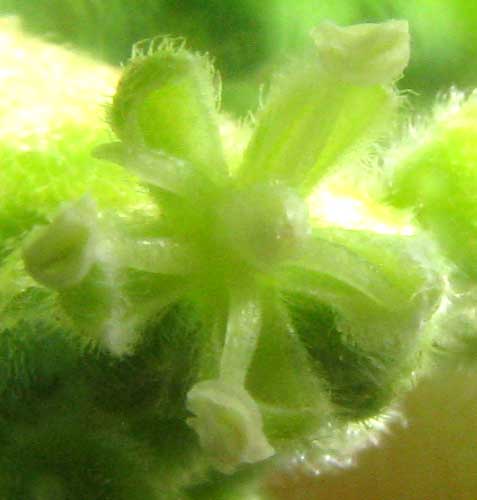Excerpts from Jim Conrad's
Naturalist Newsletter
from the November 24, 2008 Newsletter issued from Yokdzonot, Yucatán, México
"CAPULINES" FLOWERING
Back in Chiapas I introduced you to a handsomely flowering and fruiting tree called "Capulín," shown at www.backyardnature.net/chiapas/capulin.htm.
The "Capulín" flowering here now is different, shown below:

In Latin America they call just about anything with small, spherical, possibly edible fruits "Capulín." The one flowering here now is TREMA MICRANTHUM. The genus Trema was traditionally placed in the Elm Family along with elms and hackberries. However, lately gene sequencers have banished the hackberries from that family -- and Trema is close to the hackberries -- and plopped them into the Marijuana Family, the Cannabaceae, so probably that's where Trema is now. Like the hackberries, a good field mark for Trema is its large side-veins arising at the blades' bases, hinting at "palmate venation."
Whatever Trema's taxonomic affiliations, it's an important tree in these parts because when a forest is destroyed Trema micranthum is often among the first trees to grow back, its seeds being planted in open areas by birds who have eaten the fruits and deposited droppings there.

Above you see Trema micranthum's female flowers, which are beautiful examples of pistillate blossoms consisting of nothing but a hairy, 5-lobed calyx and a globose pistil, the pistil being the stigma, style and ovary. The spherical items in the picture are the ovaries. There's not much style present at all, and the fuzzy white things are the stigmas, their fuzziness serving to more effectively snatch the male flowers' airborne pollen from the air.
Inside each ovary there's just one ovule developing into a hard seed. Trema fruits, like hackberry fruits, are fleshy, one-seeded, and they don't split apart naturally, so that makes them drupes. Once Trema fruits are mature they're the size of hackberries, red to yellow-red, and, also like hackberries, there's not enough flesh there for humans to be interested in eating them, but birds just love them.
from the July 24, 2011 Newsletter issued from Mayan Beach Garden Inn 20 kms north of Mahahual; Caribbean coastal beach and mangroves, ~N18.89°, ~W87.64°, Quintana Roo state, MÉXICO
CAPULINES GALORE
Capulín is a name used for a number of cherry-like trees. One of those Capulines is a common, almost weedy tree commonly seen along roadsides here. In the Hackberry Family, it's TREMA micranthum. Nowadays they're loaded with pea-sized fruits, as shown below:

In the genus Trema, flowers are mostly unisexual, with male and female flowers usually on the same plants, plus sometimes there are bisexual blossoms -- flowers with both male and female parts. You can see a male one below:

In the Hackberry Family flowers lack corollas and petals, so in the picture the five scoop-shaped, green things are the calyx's hairy-backed sepals. Each sepal subtends a greenish, pollen-producing stamen.
The fruits are fleshy drupes containing large, hard pits, and are much appreciated by certain fruit-eating birds, such as our most common one here, the Tropical Mockingbird.